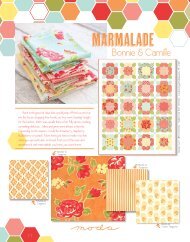Civil War Crossings
Civil War Crossings
Civil War Crossings
You also want an ePaper? Increase the reach of your titles
YUMPU automatically turns print PDFs into web optimized ePapers that Google loves.
Barbara Brackman<br />
Barbara Brackman<br />
KIT8120<br />
Quilt Size: 68"x78"<br />
Stock #KCS 6378<br />
<strong>Civil</strong> <strong>War</strong> <strong>Crossings</strong> can be coordinated<br />
with Barbara’s 2008 online Underground<br />
Railroad Club from C&T Publishing and<br />
her 2007 book about the <strong>Civil</strong> <strong>War</strong> entitled<br />
Borderland in Butternut and Blue.<br />
Samplers from either publication can be kitted<br />
in these fabrics.
THE ALLIANCE FOR<br />
AMERICAN QUILTS<br />
www.centerforthequilt.org<br />
The Alliance for American Quilts, a national nonprofit organization founded in 1993 and<br />
now headquartered in Asheville, North Carolina supports and develops projects to document,<br />
preserve, and share the history and stories of quilts and quiltmakers. The Alliance brings together<br />
institutions and individuals from the creative, scholarly and business worlds of quiltmaking to<br />
advance the recognition of quilts in American culture.<br />
Barbara Brackman<br />
The Alliance’s four core projects are:<br />
Th e Qu i lt In d e x<br />
A national online database of quilt images and records bringing together institutional and grassroots<br />
collections. Institutional partner: Michigan State University<br />
Qu i lt e r s’ S.O.S. – Sa v e Ou r St o r i e s<br />
Grassroots oral history project preserving the stories of today’s quiltmakers from all over the US<br />
and abroad. Archived at the Library of Congress’ American Folklife Center<br />
Qu i lt Tr e a s u r e s<br />
Multi-media portraits profiling key quilt revival pioneers including quiltmakers, historians, collectors,<br />
teachers. Institutional partner: Michigan State University<br />
Bo x e s Un d e r t h e Bed<br />
Rescue and recovery efforts to save quilt ephemera, preserving items families and collectors find in<br />
boxes of quilts. Institutional partner: the University of Texas at Austin, Center for American History’s,<br />
Winedale Center for the Quilt<br />
For more information, visit www.centerforthequilt.org or contact Amy Milne, Executive<br />
Director, at 828-251-7073 and amy.milne@quiltalliance.org. Mailing address: 125 S. Lexington<br />
Avenue, Suite 101, Asheville, NC 28801.<br />
The image on the right is a close-up of a block from the<br />
Eula Parris Smith quilt which was completed during<br />
the migration from Tennessee to Texas circa 1900.<br />
This quilt is archived on the Quilt Index in<br />
the University of Tennessee collection.<br />
This quilt was the inspiration for the <strong>Civil</strong> <strong>War</strong> <strong>Crossings</strong> quilt.<br />
The pattern for the <strong>Civil</strong> <strong>War</strong> <strong>Crossings</strong> quilt will be featured<br />
in Quilters Newsletter Magazine.<br />
Kits for the <strong>Civil</strong> <strong>War</strong> <strong>Crossings</strong> Quilt (KIT8120) will<br />
include a copy of the magazine.<br />
inspiration
1850-1880<br />
Barbara Brackman<br />
<br />
Barbara Brackman
8124-19 Ivory Tallulah 1850-1883<br />
ivory<br />
This reproduction collection from<br />
Barbara Brackman echos the time when<br />
America’s rivers defined battlefields<br />
North and South. Each print is named for<br />
a river — the <strong>War</strong>’s lifelines, barriers and<br />
borders. From the Susquehanna near<br />
Gettysburg, Pennsylvania to the<br />
Sabine near the Texas Gulf, the waterways<br />
marked the <strong>War</strong>’s tragic progress.<br />
Colors recreate traditional natural<br />
shades---madder, buff and Prussian blue.<br />
The prints, drawn from quilts of the time,<br />
include a patriotic postwar flag print and<br />
a tiny patchwork-like stripe. Stories of the<br />
<strong>Civil</strong> <strong>War</strong> continue to fascinate quiltmakers<br />
who will be thrilled to find authentic<br />
updates for their reproduction quilts.<br />
Barbara Brackman<br />
8121-14 Buff<br />
Susquehanna 1860-1883<br />
8123-14 Buff<br />
Suwannee 1850-1881<br />
buff<br />
8125-14 Buff Cumberland 1840-1873<br />
8125-19 Ivory<br />
Cumberland 1840-1874<br />
8121-19 Ivory<br />
Susquehanna 1860-1885<br />
8127-19 Ivory<br />
Kanawha 1860-1884<br />
8128-14 Buff<br />
Shenandoah 1860-1880<br />
<strong>Civil</strong> <strong>War</strong> <strong>Crossings</strong> by Barbara Brackman for
8129-14 Buff<br />
Rappahannock 1850-1881<br />
Fabric reduced to show detail.<br />
double pink<br />
8128-18<br />
Double Pink<br />
Shenandoah 1860-1882<br />
8120-18<br />
Double Pink<br />
Rapidan 1860-1882<br />
8123-18<br />
Double Pink<br />
Suwannee 1850-1883<br />
madder red<br />
Madder shades range from dark chocolate brown<br />
through reddish and pinkish browns, brick reds and<br />
oranges to pale salmon.<br />
8124-11<br />
Madder Red<br />
Tallulah 1850-1880<br />
8127-18<br />
Double Pink<br />
Kanawha 1860-1883<br />
8121-18<br />
Double Pink<br />
Susquehanna 1860-1884<br />
8126-14<br />
Madder Red<br />
Sabine 1850-1882<br />
Barbara Brackman<br />
8121-11<br />
Madder Red<br />
Susquehanna 1860-1880<br />
8123-11<br />
Madder Red<br />
Suwannee 1850-1880<br />
8127-11<br />
Madder Red<br />
Kanawha 1860-1880<br />
8122-11<br />
Madder Red<br />
Potomac 1870-1880<br />
8125-11<br />
Madder Red<br />
Cumberland 1840-1870<br />
<strong>Civil</strong> <strong>War</strong> <strong>Crossings</strong> by Barbara Brackman
8120-12 Prussian Blue<br />
Rapidan 1860-1880<br />
Designing<br />
Reproduction Fabrics<br />
Barbara Brackman<br />
Barbara Brackman<br />
8121-12<br />
Prussian Blue<br />
Susquehanna 1860-1881<br />
8126-12 Prussian Blue<br />
Sabine 1850-1880<br />
8122-12 Prussian Blue<br />
Potomac 1870-1881<br />
8125-12<br />
Prussian Blue<br />
Cumberland 1840-1871<br />
The designer has to keep two major factors<br />
in mind when reproducing accurate fabrics. One is<br />
finding an authentic print; the other reproducing the<br />
colors of natural dyes.<br />
Because print styles changed with fashions and<br />
technology, the designer needs a large file of fabric<br />
with different images and sets. Designers call these<br />
old fabrics “document prints”. For <strong>Civil</strong> <strong>War</strong> <strong>Crossings</strong><br />
I was thinking of the decades from about 1860 to1880<br />
when popular styles included foulard prints (regularly<br />
repeated small figures that often form a diagonal grid),<br />
paisleys (India-inspired designs), patriotic themes and<br />
striped sets.<br />
I find my document prints by collecting old blocks,<br />
fabrics and quilt tops. Several friends contributed to<br />
this line. Katy Christopherson gave me a block with<br />
the patriotic flag print, probably from the mid-1870s<br />
when the Centennial exhibition celebrated national<br />
unity. Collector extraordinaire Arnold Savage gave me<br />
the large paisley stripe.<br />
I am always looking for prints that are not only<br />
authentic but marketable. For example, some foulard<br />
prints that were so popular during the <strong>Civil</strong> <strong>War</strong> for<br />
women’s clothing can look too spotty<br />
to appeal to today’s quilters. A fabric<br />
perfect for a hoop-skirted dress might<br />
be hard to incorporate into harmonious<br />
patchwork. I balanced the <strong>Civil</strong><br />
<strong>War</strong> <strong>Crossings</strong> collection with a few<br />
stripes, a few gridded repeats and<br />
a few of the all-over repeat that<br />
designers call “tossed”.<br />
Accurate coloring requires a compromise between<br />
what was available 150 years ago and what is possible<br />
today. Nineteenth-century mills using natural<br />
dyes for cotton prints were limited in the colors they<br />
could obtain as well as in the color combinations<br />
possible. Today’s synthetic dyes can give us any color<br />
in any combination---a true luxury. But sometimes<br />
it’s difficult to obtain the old look. For example, the<br />
<strong>Civil</strong> <strong>War</strong> <strong>Crossings</strong> by Barbara Brackman for
unusual yellow-green we love in old applique quilts<br />
was produced by over dyeing blue and yellow, a twostep<br />
process that produces a vibrancy hard to capture<br />
with synthetic dyes. Then time added another step<br />
to the process. The old fabrics faded with light,<br />
washings and decades of wear resulting in a variety<br />
of quirky greens which are just about impossible<br />
to replicate.<br />
But we are able to copy many of the authentic<br />
colors. <strong>Civil</strong> <strong>War</strong> <strong>Crossings</strong> captures well the<br />
warm browns popular in the mid-nineteenth century,<br />
colors known as Madder Style because they were dyed<br />
with the root of the madder plant. Madder shades<br />
range from dark chocolate brown through reddish<br />
and pinkish browns, brick reds and oranges to pale<br />
salmon.<br />
Madder dyes also produced<br />
a clear pink in a style that dyers<br />
called Double Pink because they<br />
usually printed two different shades<br />
of pink on a white ground. <strong>Civil</strong><br />
<strong>War</strong> <strong>Crossings</strong> offers several copies of<br />
the classic fashionable for quilts and<br />
little girl’s clothing throughout the century.<br />
Mid-century blues came primarily from indigo<br />
or Prussian blue dye, both of which give a<br />
range from sky blue to the dark blue of a Union soldier’s<br />
uniform. Prussian blue was often printed with a<br />
neutral tan shade called buff. The buff and blue color<br />
combination was in vogue for clothing and decorating<br />
from about 1840 to 1865.<br />
<strong>Civil</strong> <strong>War</strong> reproductions are popular not only<br />
because of their link to the war, but also because the<br />
mid-nineteenth century was a time of clever design,<br />
harmonious colors and technological innovations<br />
that produced cotton fabrics<br />
with classic appeal.<br />
8124-12<br />
Prussian Blue<br />
Tallulah 1850-1881<br />
8125-22<br />
Dark Blue<br />
Cumberland 1840-1875<br />
8128-15<br />
Prussian Blue<br />
Shenandoah 1860-1881<br />
8127-12<br />
Prussian Blue<br />
Kanawha 1860-1881<br />
Prussian blue<br />
Barbara Brackman<br />
To read more about<br />
Double pinks and quilts<br />
of the last century,<br />
look for Barbara’s new book<br />
Making History: Quilts and Fabric from 1890 to 1970<br />
from C&T Publishing. (Stock #10569)<br />
8129-15 Prussian Blue<br />
Rappahannock 1850-1881<br />
<strong>Civil</strong> <strong>War</strong> <strong>Crossings</strong> by Barbara Brackman
8129-13<br />
Chocolate Brown<br />
Rappahannock 1850-1881<br />
8122-13 Chocolate Brown<br />
Potomac 1870-1882<br />
8127-13 Chocolate Brown<br />
Kanawha 1860-1882<br />
chocolate brown<br />
8126-13<br />
Chocolate Brown<br />
Sabine 1850-1881<br />
8123-16 Rust<br />
Suwannee 1850-1882<br />
Barbara Brackman<br />
8124-13 Chocolate Brown<br />
Tallulah 1850-1882<br />
8120-13 Chocolate Brown<br />
Rapidan 1860-1881<br />
8121-13<br />
Chocolate Brown<br />
Susquehanna 1860-1882<br />
Delivery: September, 2008<br />
8125-13<br />
Chocolate Brown<br />
Cumberland 1840-1872<br />
Asst. 8120-10 10 Yards of Each-Prints<br />
Asst. 8120-15 15 Yards of Each-Prints<br />
Asst. KIT8120 15 Yards of Each-Prints<br />
8120AB Bundle: 40 Skus<br />
8120JR Jellyroll – (40)2½"x45" Strips – Pk 4<br />
8120LC Layer Cake – (40)10"x10" Squares – Pk 4<br />
8120PP 5"x5" Squares – Pk 25<br />
KIT8120 –Kit includes fabric, pattern & binding<br />
Skus: 40 Prints<br />
Content: 100% Cotton<br />
<strong>Civil</strong> <strong>War</strong> <strong>Crossings</strong> by Barbara Brackman for



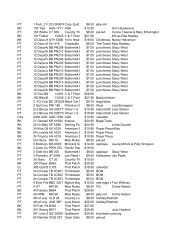
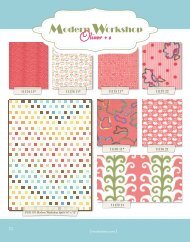
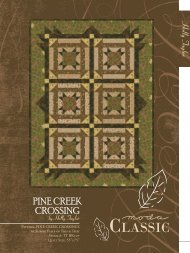
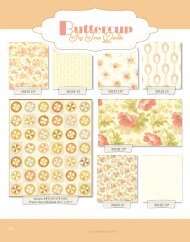
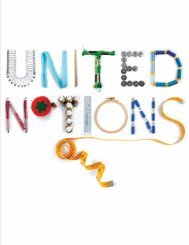
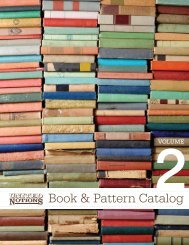
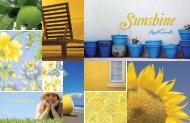
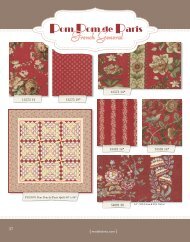
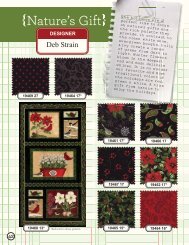
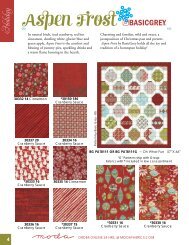
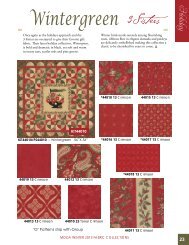
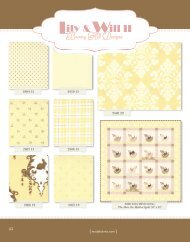
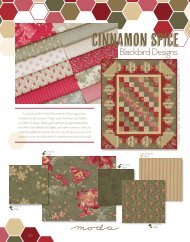
![Adult Mannequin pattern for Lissa [Converted].ai](https://img.yumpu.com/27599346/1/190x245/adult-mannequin-pattern-for-lissa-convertedai.jpg?quality=85)
